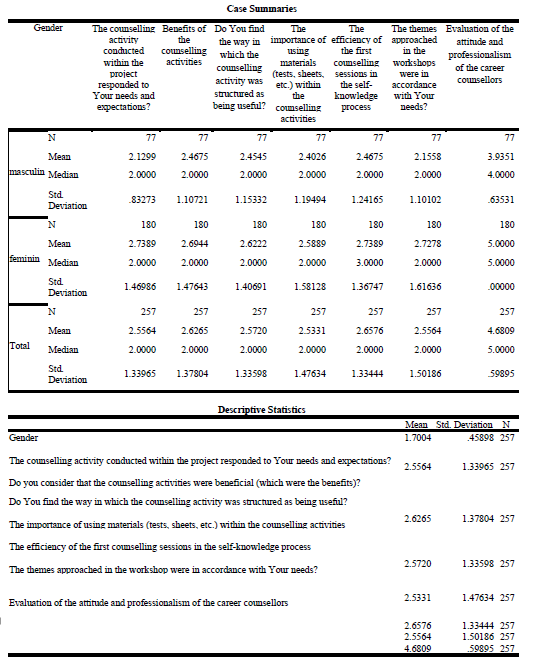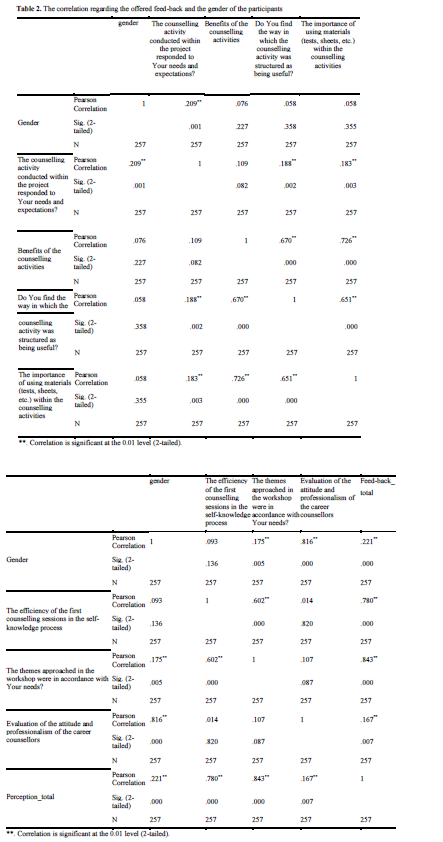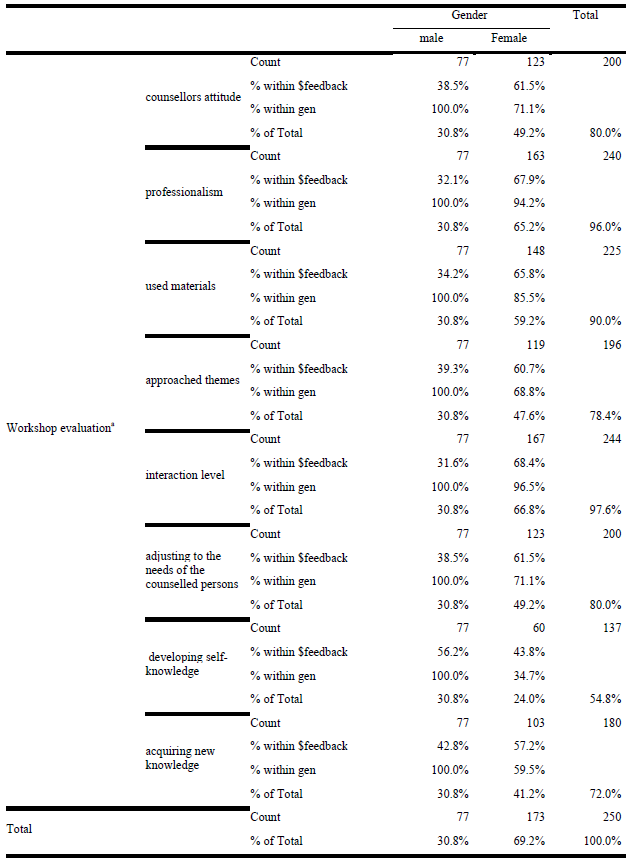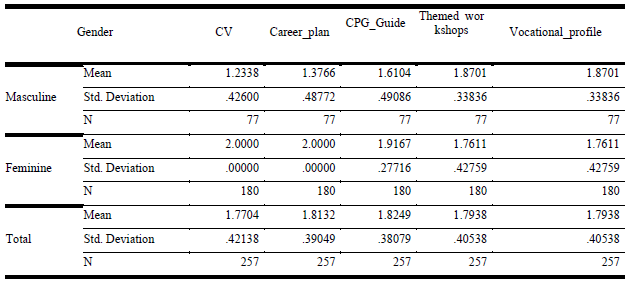Abstract
Students' perception concerning the career counselling programs is determined by the extent to which these programs are adjusted to their counselling needs. The present study is based on a constatative and correlational design and is conducted on a population of 257 students (N=257). These participants were aged between 19 and 21 years. 77 were males and 180 females.The research aims to investigate how the career counselling activities, conducted during the SOPHRD program SOPHRD/161/2.1/G/137510 entitled
Keywords: Career counsellingcounselling programscounselling needsgender differencescounselling activities
Introduction
Kavale (2012) pointed out that career counselling needs of young people and adolescents have
often been approached, in terms of attitudes, beliefs, potential solutions to problems, beliefs, satisfactions/
dissatisfactions, aspirations or in terms of wishes. Among the studies that have approached this issue
more objectively we can mention the study offered by Fouad et al. (2006) that investigated the needs of
awareness and use of counselling services among students. The authors of this study analyzed the
counselling needs from the perspective of three dimensions, namely the need to evaluate, the level of
awareness and the extent of use of offered services. Based on the obtained data, the research team
confirmed that the students indicated counselling needs both in terms of career decision and also of
aspects regarding the stress determined by this stage. Additionally, in a study conducted by Crișan,
Pavelea and Ghimbuluț (2014) on a sample of 130 bachelor students it was found that the students are
poorly informed regarding employment opportunities and that their expectations for the future are not
connected with their own knowledge and skills, having no coherent outlined career plan and thus facing
major obstacles in the process of career decision making. This fact indicates that the students present a
low degree of awareness of the advantages they can benefit from after the involvement in career
counselling programs.
Another study, conducted this time on a sample of 900 10th-grade students, by Volodina & Nagy
(2016) examined the role of gender, among other variables, such as school achievement, self-concepts
and vocational interests, within the vocational choices in adolescence, namely for predicting the transition
from school to different fields of education and training. They obtained 50% common variance for the
gender variable, which means that vocational interest were most closely linked to gender.
The role of career counsellors and students' perception on the services provided by these
counsellor have been widely discussed in the literature (Walker et al, 2006; Alloway, Walker, Patterson,
Dalley & Lenoy, 2004; Aspen, et al., 2015). Thus, if many studies highlight the benefits of implementing
such programs at the curriculum level (Brown & Ryan, Krane, 2000; Whiston, Sexton & Lasoff, 1998),
there are also studies that indicate the reluctance of beneficiaries in the recourse to such services, either as
a consequence of the lack of information or as uncertainty in the identification of potential solutions to
the problems they are facing (Menon, 2010; Agi, 2014). Taking these aspects into account, Egbo (2015)
considers that individually respecting and recognizing of students are essential for the proper conducting
of the career counselling and guidance programs, which have positive consequences on the effectiveness
of the programs and, implicitly, on the attitude of the beneficiaries regarding the quality of these
programs. Furthermore, the positive relationship between the counsellor and the person being counseled,
based on trust and commitment, orientation towards individual needs more than towards providing
information, (Patterson and Levy, 2007) facilitates the effective conduct of the counselling activities,
having beneficial effects on students (Badu, 2011). Rafeffebsperger (2010) quoted by Awinsong, Dawson
and Gidiglo (2015) confirmed by a performed study that a positive counselling relationship is essential
for the success of the counselling process. Confidentiality, flexibility, adjusting to the needs of the
persons being counseld and the location of the counselling centers facilitate all the establishment of a
positive relationship between counsellor and counseled. Kirschner et al. (2008) found that if the
counsellor focuses more on feelings, insight, challenges, it can facilitate a favorable context in which the
client can acquire a significant increase in self-understanding, hope, taking responsibility and achieving
new perspectives.
Hirschi and Lage (2008) investigated the efficiency of long term career counselling by
implementing a career counselling program for Swiss teenagers. They observed that career decision,
career planning, exploring the occupational environment and vocational identity increased significantly
during the 3 months that the program lasted. Some authors (Bimrose & Barnes, 2006; Bimrose, 2008) conducted, within a longitudinal study, a
research regarding the efficiency of career counselling on a sample of 50 teenagers from England. The
participants described the use of counselling during the 5 years of study. They discovered that career
counselling is useful when specialized information was assured, including information related to the
labour market, details about training courses, trainings, employment opportunities; and also when certain
alternatives were offered in order to help them concentrate and to motivate them, to increase their self-
confidence, their self-awareness and also when structured opportunities for reflection and debate were
proposed. One of the main conclusions of this study showed a decrease of the unemployed students from
34% to 3%.
Luzzo (1995) mentioned a study conducted by Farmer (1985) that showed that wemen are much
more likely than men to experience effects of confusion and environmental factors of stress within the
process of career development. This can mean that career counselling programs are more likely to be
useful for females than for males, responsing better to their specific needs.
The present study aims to investigate students' perception concerning the effectiveness of the
counselling program, implemented within the SOPHRD program, according to their career counselling
needs. This study can also be considered as a try to fill in the present gap in knowledge in the field of
studies and researches conducted in order to identify students’ perception about career counselling
programs.
Methodology of the Conducted Research
2.1.Participants
The study was conducted on a sample of 257 participants aged between 19 and 21 years (M=20,3,
SD=1,2) of which 77 were males and 180 females. All participants are students of the
University Cluj-Napoca, Romania and are beneficiaries of the career counselling program conducted
within the SOPHRD/161/2.1/G/137510 program – Professional counselling, internships and simulated
enterprise: an extra chance in finding a job for students specializing in public administration and
communication, public relations and advertising.
The participation in the investigation was voluntary and anonymous. Participation agreements,
data confidentiality and other ethical aspects were assured.
2.2.Measures
The data regarding the students' perception concerning the efficiency of the career counselling
program was collected by applying a questionnaire that included 7 closed-ended questions, the answers
being recorded on a Likert scale from 1 to 5, where 1 means full compliance (very much) and 5 reffers to
the lack of compliance (not at all). The following aspects were aimed within the questionnaire: Q1.
adjustment to the counselling needs of students; Q2- benefits of career counselling activities; Q3 – the
way of structuring the career counselling program; Q4-effectiveness of the materials used within the
program; Q5 – the efficiency of self-knowledge activities; Q6 – the themes approached within the themed
workshops, and Q7- the attitude and professionalism of the career counsellors.
The questionnaires were applied after completion of the entire career counselling program, in the
paper-pencil form, being filled in by each student individually.
2.3.Research Design
In the present study we chose a correlational design, in order to investigate the relationship
between the two genders (female and male) and the effectiveness of the career counselling program. In
this respect, we started from the following research questions:
Q1 Are there significant differences between the participants, according to their gender, in terms
of providing feedback regarding the benefits of the conducted counselling program?
Q2 Are there gender differences regarding the following aspects: evaluation of counsellors, the
level of interaction within the counselling activities and the adjustment of the counselling sessions to the
students' needs?
Q3 Are there gender differences between the aspects appreciated by the participants in the
implemented career counselling program?
2.4.Procedure
In the first stage all participants to this study were informed about the aim of the investigation and
about the instrument used for data measuring. Thus after participating to the career counselling program,
within the program SOPHRD/161/2.1/G/137510 – Professional counselling, internships and simulated
enterprise: an extra chance in finding a job for students specializing in public administration and
communication, public relations and advertising, the students filled in a feed-back questionnaire. The
questionnaire was completed in paper-pencil form and was applied to each student individually. The
questions focused on the students’ perception regarding the efficiency of the conducted activity within the
program.
The career counselling program included minimum 3 counselling sessions for each student, of
which one individual session and 2 group sessions. In the individual session each student discussed with
the counsellor about his own vocational profile, about his counselling needs and developed an initial
career plan. In the group sessions the students filled in several psychological tests based on which a report
regarding their psychological and vocational profile was made. Also, the students had the possibility to
participate to several themed workshops (minimum one workshop). Within the workshops aspects
regarding the field of career counselling were approached.
The students evaluated the whole program based on the conducted activities. Their evaluation was
carried out in light of seven different aspects. The opinions provided by students allowed us to identify
their perception regarding the program efficiency.
Results and Discussions
According to the obtained data, we can observe significant gender differences between male and
female students in the feed-back offered regarding the benefits brought on them by the career counselling
program. The feed-back consisted in expressing opinions about the benefits brought by this counselling
program. By analyzing the values of mean and standard deviation included in Table 1, we observe
significant differences regarding some aspects related to the workshop quality. For example, female
participants (M=2,73; SD=1.46) argue that the activities conducted within the program were organized
taking into account their needs and expectations, while the male participants don’t share the same opinion
(M=2,12; SD=0.83). Also, regarding the benefits of the counselling activities the female students
(M=2,69; SD=1.47) consider that these were beneficial for their career decision as against the male
participants (M=2,46; SD=1.10), who have another perception. Gender differences are also found
concerning the following issues: importance of using certain instruments and materials within the
counselling sessions (female: M=2,58; SD= 1.58; male: M=2,41; SD=1.19), counselling sessions
designed with the aim of developing a high level of self-knowledge (female: M=2,73; SD=1.36; male:
M=2,46; SD=1,24), themes and subjects approached in the counselling sessions (female: M=2,72; SD=
1.61; male: M= 2,15; SD=1.10) and also the evaluation of the career counsellors at professional and
attitudinal level (female: M=5; SD=0; male: M= 3,93; SD=0.63).

The correlations presented in Table 2 show that there is a significant positive correlation between
gender and the following aspects mentioned in the feed-back offered by students: appreciation of the
counselling sessions for being focused on the desires and needs of the participants r(255)=0,20, p<0,01, (255 represents the freedom degrees, df=N-2, where N represents the number of the participants), which
means that between the two variables is no association; the quality of the approached themes and subjects
within the counselling process r(255)=0,17, p<0,01 and the evaluation of the attitude and professionalism of the career counsellors r(255)=0,81, p<0,01. Instead, there is no significant statistical correlation between gender and the following three elements: the evaluation of the benefits of the counselling sessions
(r(255)=0,72, p=0,22), the evaluation of the used methods (r(255)=0,58, p=0,33) and the evaluation of the counselling sessions based on developing the self-knowledge (r(255)=0,93, p=0,13). So, we can affirm that the first hypotesis of this study is confirmed only partially.

Regarding the differences that exist between gender and the appreciation of the counsellors, the
interaction level within the counselling sessions and the adjustment of the counselling sessions to the
needs of the students, the obtained values included in Table 2 demonstrate that the female students
appreciated more than the male participants the following aspects: the counsellors attitude, the interaction
level and the adjustment of the counselling sessions to their needs and wishes.

Analysing the beneficial aspects of the counselling activities in relationship with the gender of the
participants, Table 3 shows that from the total of the valid cases (250 subjects), 123 girls (49,2%)
appreciated the attitude of the counsellors. 167 girls that appreciated the interaction level during the
counselling sessions represent 66,8% from the total of participants that appreciated at least one aspect
within the counselling sessions and 123 girls (49,2%) considered as an important aspect the adjustment of
the counselling activities to their desires and needs. However, 77 men (30,8%) appreciated that conducting an activity that aims developing a high level of self-knowledge is a positive aspect of the
counselling sessions.
Perception differences were also found, according to the gender differences, at the level of the
aspects appreciated by the participants within the implemented counselling program, as it can be observed
by analysing the values included in Table 3.

Comparing the results from Table 4 we observe that there are significant differences between the
means registrated for the participants to the present study. The differences are related to the usefulness of
the information provided within the counselling sessions for the insertion of students in the labour
market. Thus the female subjects claim that resume (CV) writing (M=2, SD=0), the career plan writing
(M=2, SD=0), and also the information from the guide of counselling and professional guidance
(M=1.91, SD=0.27) were useful for them, in comparison with the students that affirm that the themed
workshops (M=1,87; SD=0.33) and the identification and evaluation of features, values and skills that
compose the vocational profile of each student will help them to integrate in the labour market (M=1,87;
SD=0,33).
In conclusion, there are gender differences in the students' perception concerning the career
counselling program. Thus the female participants belive that the activities conducted within the program
were organized taking into account their needs and expectations, considering them useful for their
decision regarding the career, as against the male participants, who didn’t share this opinion. The female
subjects also apreciated more than the male ones the following aspects: the counsellors attitude, the
interaction level and the adjustmend of the career counselling to their needs. In case of the female
participants the most appreciated aspects within the program were related to the information regarding the
resume (CV) writing and the career plan, while by the male subjects the identification of the vocational
aspects (features, values, skills, abilities) was the most appreciated aspect.
Conclusions
The practical implications of this study include the importance of the awareness of the counselling
needs of students. Also, as the results show us, it is important that a counsellor tries to adjust the career
counselling activities according to the gender of the counselled persons in order to be as efficient as
possible, since males and females have different opinions regarding their future professional life.
It is also important to mention some of the limits of the present research that represent
simultaneously proposals for future studies approaching the same issue.
One of the limits of the above presented study is referring to the unequal number of the
participants; the study was conducted on a sample composed of 77 males and 180 females. This unequal
number of participants according to the gender variable can influence significantly the obtained results.
Another issue is that the participants are students specializing in a specific small number of domains,
namely: public administration and communication, public relations and advertising. A similar study could
be conducted in the future on a sample that is equal from the point of view of the gender of the
participants and also on a sample of students specializing in many other fields of study (for example
psychology, educational sciences, sociology).
The activities included in the career counselling program could also be more varied and better
adjusted to the specific features and needs of male and female participants, for example themes such as
social expectations for women and men could be approached within the workshops.
The instrument used in the present study consisted in a questionnaire. This instrument was created
by the researchers and it is not a validated instrument. Further studies in this field could use instruments
that fulfil better the criteria of validity. Also, the collection of data regarding students’ opinion could be
done by using a larger number of research instruments, both quantitative and qualitative.
References
- Agi, C.W. (2014). „Evaluation of students’ perception of school counselling and their attitudes towards
- its programme”. Arabian Journal of Business and Management, 2, 5.
- Alloway, N., Dalley, L., Patterson, A., Lenoy, M., & Walker, K (2004). „School students making education and career decisions: aspirations, attitudes and influences”. Canberra: DEST.
- Aspen, T., Cooper, R., Liu, Y., Marowa, M., Rubio, C., Waterhouse, E.J., & Sheridan, J. (2015). „What secondary schools advisors in New Zealand know about pharmacy and how that knowledge affects students’ career choice”. American Journal of Pharmaceutical Education, 79 (1).
- Awinsong M., Dawson O., Gidiglo E.B. (2015) “Students’ Perception of the Role of Counsellors in the Choice of a Career: a study of the Mfantseman Municipality in Ghana” International Journal of Learning, Teaching and Educational Research Vol. 13, No. 3, pp. 79-99 Badu, K.G. (2011). „Interpersonal Relationship at Cape Coast”. Journal of Counselling, Education and Psychology. 16, 188-124.
- Bimrose, J., Barnes, S-A. (2006). „Is career guidance effective? Evidence from a longitudinal study in England”, Australian Journal of Career Development, 15 (2), 19 - 25 (1038-4162) Bimrose, J. (2008). „Guidance for girls and women”, in International handbook of career guidance, 375- 404, Editors: Athanasou, J. A. and Van Esbroeck, R. Dordrecht ; London: Springer Brown, S.D., Ryan Krane, N.E. (2000). Four (or five) sessions and a cloud of dust: Old assumptions and new observations about career counselling. In S.D. Brown & R.W. Lent (Eds.), Handbook of Counselling Psychology (3rd ed., pp. 740-766). New York: Wiley.Brown & Ryan, Krane, 2000; Crișan, C., Pavelea, A., Ghimbuluț, O. (2014). „A Need Assessment on Students’ Career Guidance” Procedia - Social and Behavioral Sciences 180 (2015) 1022 – 1029 Egbo, J.O.E. (2015). Guidance and counselling: a creativity for promoting sustainable well-being and adjustment of secondary school students in nigeria. British Journal of Education, 3 (10), 49-57.
- Fouad, N. A., Gerstein, L. H., & Toporek, R. L. (2006). „Social justice and counselling psychology in context”. In R. L. Toporek, L. H. Gerstein, N. A. Fouad, G. Roysircar, & T. Israel (Eds.), Handbook for social justice in counselling psychology: Leadership, vision, and action (pp. 1-16). Thousand Oaks, CA: SAGE.
- Hirschi A., Läge D. (2008). „Increasing the career choice readiness of young adolescents: an evaluation study” International Journal for Educational and Vocational Guidance 8:95–110 Kavale (2012). „Needs and Needs Assessment in Career Guidance and Counselling: Lack of Scientific Exploration and Justification?” Indian Journal of Career and Livelihood Planning Journal of the Indian Association for Career and Livelihood Planning (IACLP) Volume 1, Issue 1 Kirschner P. A. Schaap H., de Bruijn E., van der Schaaf M. (2008). „The Value of Personal Professional Theories for Vocational Education”. None (EN).
- Luzzo, D.A. (1995). „Gender Differences in College Students’ Career Maturity and Perceived Barriers in Career Development” Journal of Counseling and Development, Volume 73, Issue 3, 319-322 Menon, M.E. (2010). „The effect of career counsellors on the decision to pursue higher education: a mixed-methods investigation”. Journal of Further and Higher Education, 34, (4), 519–536 Patterson, J., Levy, G. (2007). „How counselling changed my life”. Community Living, 20(4), 24-25. Rafeffebsperger, M.K. (2010). „Faciltating positive counselling outcomes for clients with an intellectual disabity”. Doctoral thesis: University of Canteburry Volodina, A., Nagy, G. (2016). „Vocational choices in adolescence: The role of gender, school achievement, self-concepts and vocational interests”. Journal of Vocational Behavior 95-96 (2016) 58-73 Walker, Alloway, Dalley-Trim Patterson (2006). „Counsellor practices and student perspectives: perceptions of career counselling in Australian secondary schools”. Australian Journal of Career Development, 15 Whiston, S.C., Sexton, T.L., Lasoff, D.L. (1998). „Career-intervention outcome: A replication and extension of Oliver and Spokane”. Journal of Counselling Psychology, 45(2), 150-165
Copyright information

This work is licensed under a Creative Commons Attribution-NonCommercial-NoDerivatives 4.0 International License.
About this article
Publication Date
25 May 2017
Article Doi
eBook ISBN
978-1-80296-022-8
Publisher
Future Academy
Volume
23
Print ISBN (optional)
-
Edition Number
1st Edition
Pages
1-2032
Subjects
Educational strategies, educational policy, organization of education, management of education, teacher, teacher training
Cite this article as:
Crisan, C., Albulescu, I., & Oltean, A. (2017). Students Perception Concerning the Career Counselling Programs. In E. Soare, & C. Langa (Eds.), Education Facing Contemporary World Issues, vol 23. European Proceedings of Social and Behavioural Sciences (pp. 897-907). Future Academy. https://doi.org/10.15405/epsbs.2017.05.02.110
